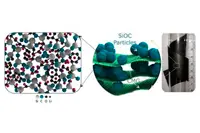 A team of researchers from Kansas State University, led by Gurpreet Singh, associate professor of mechanical and nuclear engineering, has created a paperlike battery electrode using silicon oxycarbide-glass and graphene.
A team of researchers from Kansas State University, led by Gurpreet Singh, associate professor of mechanical and nuclear engineering, has created a paperlike battery electrode using silicon oxycarbide-glass and graphene.
The battery electrode is claimed to be more than 10% lighter than other battery electrodes and has close to 100% cycling efficiency for more than 1000 charge discharge cycles. It is made of low-cost materials that are byproducts of the silicone industry. And it functions at temperatures as low as -15°C, which suits it to numerous aerial and space applications.
Prof Singh said: "The paperlike design is markedly different from the electrodes used in present day batteries because it eliminates the metal foil support and polymeric glue -- both of which do not contribute toward capacity of the battery."
Until now, it has been difficult to incorporate graphene and silicon into practical batteries because of challenges that arise at high mass loadings, such as low capacity per volume, poor cycling efficiency and chemical-mechanical instability.
Prof Singh's team has addressed these challenges by manufacturing a self-supporting electrode consisting of a glassy ceramic called silicon oxycarbide sandwiched between large platelets of chemically modified graphene. The electrode is said to have a capacity of approximately 600mA-hours per gram.
The silicon oxycarbide material is prepared by heating a liquid resin to the point where it decomposes and transforms into sharp glasslike particles. The silicon, carbon and oxygen atoms get rearranged into random 3D structure and any excess carbon precipitates out into cellular regions. Its open 3D structure creates large sites for reversible lithium storage and smooth channels for lithium-ion transportation. This structure and mechanism of lithium storage is different than crystalline silicon electrodes. Silicon oxycarbide electrodes are expected to be low cost because the raw material (liquid resin) is a byproduct of the silicone industry.
Moving forward, Prof Singh and his team want to address practical challenges. Singh's goal is to produce this electrode material at larger dimensions. For example, present-day pencil-cell batteries use graphite-coated copper foil electrodes that are more than one foot in length. The team also wants to perform mechanical bending tests to see how they affect performance parameters.
"Ultimately, we would like to work with industry to explore production of lithium-ion battery full-cells," Prof Singh said. "Silicon oxycarbide can also be prepared by 3D printing, which is another area of interest to us."
Author
Tom Austin-Morgan
Source: www.newelectronics.co.uk

